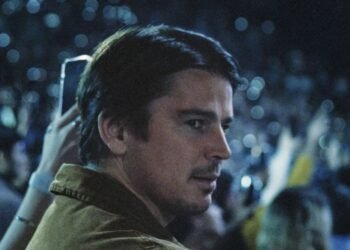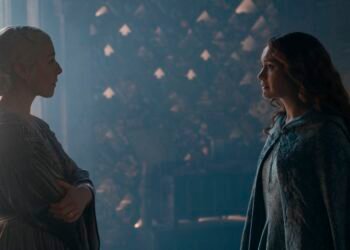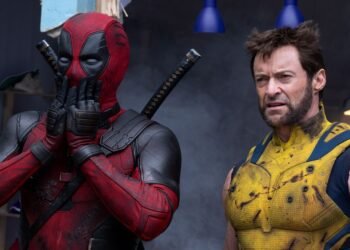A generation of readers knows R.L. Stine for his bestselling Goosebumps series, the children’s horror novels published throughout the early-to-late ’90s that spawned dozens of spinoff series, a television series, and two live-action feature films starring Jack Black as Stine himself. By contrast, Stine’s young-adult Fear Street horror series, which predates Goosebumps, never amassed quite the same degree of mainstream recognition, even though it sold more than 80 million copies as of 2010. That might change with Fear Street Part One: 1994, the first in a trilogy of horror films loosely inspired by Stine’s original stories and set to release over the next three weeks on Netflix.
Horror-movie franchises are nothing new, with the likes of Nightmare on Elm Street, Friday the 13th, Halloween, Scream, and the ridiculously complicated Saw series spawning dozens of combined sequels and follow-ups in the decades since their respective debuts. Where the Fear Street series differs is that the emphasis on sequels was in the design from the jump. The films are emulating franchises like the Marvel Cinematic Universe, telling an interconnected story across three anthology-style movies set in and around the fictionalized town of Shadyside, Ohio. Each one was inspired by the horror tropes of its respective time period.
The first installment, set in the early 1990s, follows a group of Shadyside teenagers who are attacked by a malevolent masked killer responsible for a massacre at their local mall. While attempting to escape their would-be murderer, the teens unearth the town’s history of inexplicable horror and violence. It appears to be inextricably linked to the very beginning of Shadyside’s acrimonious relationship with its neighbor, the idyllic, prosperous town of Sunnyvale. By all appearances, Fear Street Part One: 1994 is a conventional contemporary riff on ‘90s horror classics like I Know What You Did Last Summer, The Faculty, and Scream, period-accurate needle drops and all. But the film’s characters, and in particular their relationship and rapport, elevates it beyond a simple send-up to its forebears.

Photo: Netflix
Fear Street Part One: 1994 opens on the scene of a gruesome murder-to-be, then cuts to Deena (Kiana Madeira), a taciturn teenager at Shadyside High School, penning an angry break-up letter to her partner Sam. Between her alcoholic absent father, her introverted and geeky brother Josh (Benjamin Flores Jr.), and her dwindling prospects at a fulfilling future in her hometown, Deena has a lot on her mind for a girl her age, even before reckoning with the fact that yet another of her classmates has been butchered.
As members of the pep band, Deena and her friends Kate (Julia Rehwald) and Simon (Fred Hechinger) are forced to attend a candlelit vigil in honor of their classmate Maya (Maya Hawke) at Sunnyvale High. The film puts the class divide between the two towns front and center, with Shadyside’s dilapidated suburbs juxtaposed against Sunnyvale’s pristine houses and immaculately well-kept lawns. During the ceremony, Deena spies Sam with someone else, and it becomes clear for the first time that Sam is also a high-school girl. Same-sex relationships are rare in horror throwbacks, let alone as the central relationship of a horror film, period. (Mulholland Drive notwithstanding.) Deena and Sam’s relationship isn’t just representation for representation’s sake: It’s a depiction of young queer love that plays on the audience assumptions inherent in the genre, while showing how natural and affirming they are.
The fallout and what follows between Deena and Sam serves as the emotional crux of the film, with both Madeira and Olivia Scott Welch creating a convincing dynamic as an estranged pair of closeted lovers whose relationship is strained by their differences in class and social status. The supporting cast deliver some great performances too, with Rehwald and Hechinger providing much of the film’s comic relief as an odd-couple pair of pep-band members moonlighting as drug dealers. Flores Jr. as Josh is the lynchpin for several of the film’s most significant beats: His voluminous knowledge of the occult and the town’s sordid history of murder gives his group the means to tackle the threat of the Skull Mask Killer.
One twist on the conventional slasher formula that Fear Street: 1994 introduces, and which will likely serve as the throughline connecting all three of the films, is the element of the occult in the form of Sara Feir, the film’s antagonist. Hanged as a witch several hundred years before the events of the film, Feir left behind a legacy — and a mysterious generation-spanning vendetta for one of the characters — that may be the source of much of the misfortune and horror plaguing Shadyside. Feir has possessed several otherwise innocent townspeople across history and twisted them to commit acts of gruesome violence for some unknown purpose. The twists that spring from out of this revelation make for some entertaining and shocking scenes in the latter half of the movie, culminating in several shocking kills where the brutality stands out from the otherwise chaste violence of the rest of the film.
It’s unclear yet whether this attempt at the MCU-nification of young-adult horror will come together in a satisfying way, but at the very least, Fear Street: 1994 lays a solid foundation. It’s a spooky, pulse-pounding horror romp with likable characters and terrific scares. If not for the dangling plot threads peppered throughout the course of the film, including a major moment in the final act, Fear Street: 1994 would make for a perfectly fun and serviceable horror flick on its own. It’ll be fascinating to see how Fear Street Part Two: 1978 carries its momentum forward while stepping backward in time.
Fear Street Part One: 1994 launches on Netflix on July 2.















































